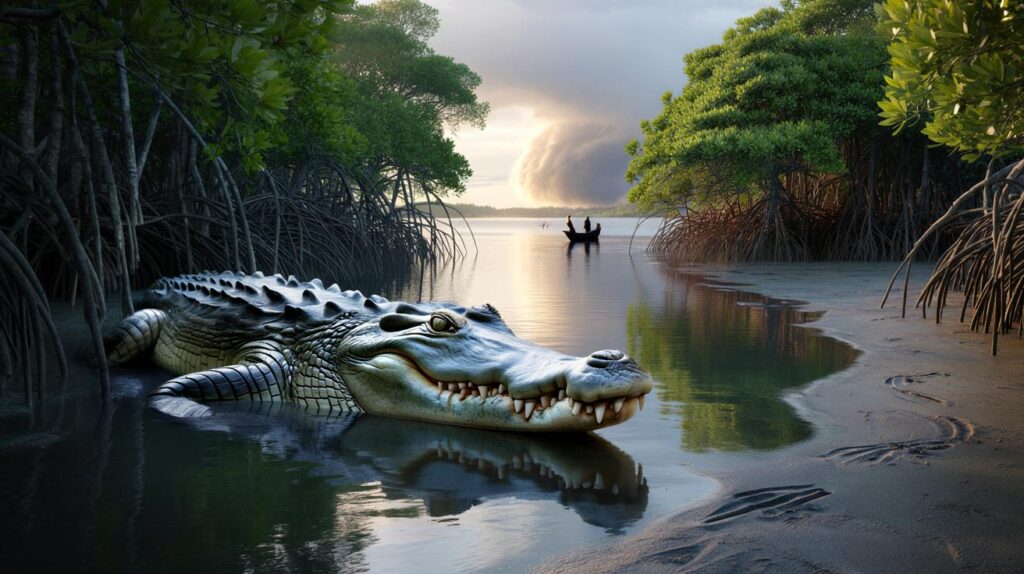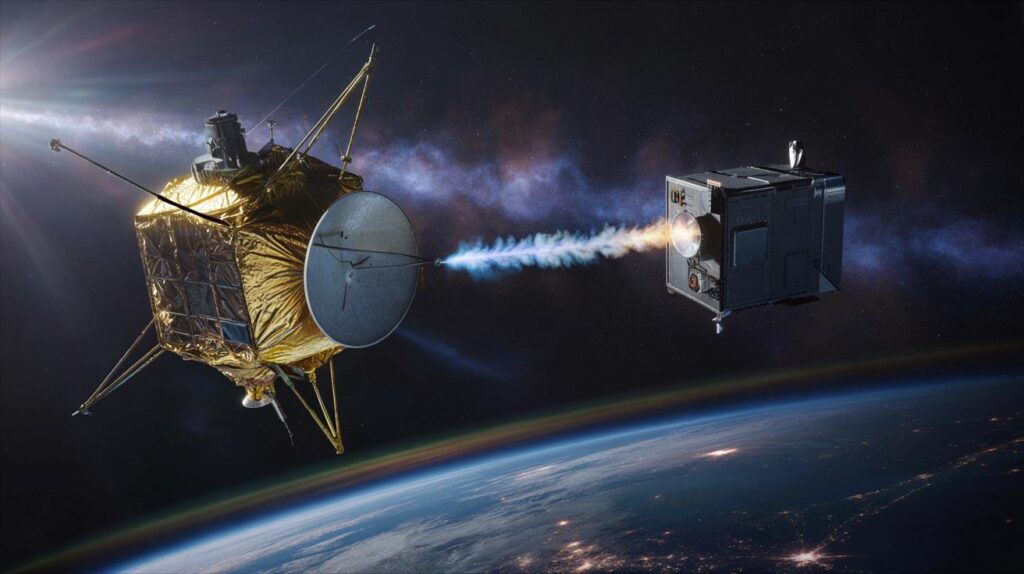A massive crocodile emerges from the dark mangrove waters, its jaws resembling shattered porcelain, featured in one of 20 images currently captivating audiences at the Mangrove Photography Awards 2025. These are not merely beautiful photographs, but a wake-up call: evidence that wild environments continue to make headlines.
A stillness enveloped the creek, a hint of saltiness in the air, as if the mud recalled the warmth of the sun. The light gradually increased, first silver, then pewter, and finally something warm enough to inhale.
That was when the crocodile ascended. It wasn’t a jump or a lunge—just a gentle rise from the depths, so immense it appeared as geography before it was recognized as an animal. Cameras clicked like raindrops on metal roofs. The mangroves observed silently, their roots intertwined, patient and ancient.
We’ve all experienced that moment when a photograph halts our scrolling, coffee cooling in our hands. This one did even more. It transformed the creek into a corridor, with each of us as an open door. Then the eyes blinked.
A gaze that lingers.
Twenty images, one planet exhaling
The crocodile photograph serves as the foundation of the collection, like a rhythmic beat. It’s a depiction of size and restraint, a creature the length of a canoe weaving through roots, light fracturing into shards along its back. You can almost hear the wet sound of mud releasing a foot, the careful calculations of a predator that spares nothing.
Across the finalists, the theme is straightforward: **untamed nature**. A kingfisher hovers in midair, its wings caught by the dawn’s light. In another shot, a swarm of crabs scuttles across a moonlit flat like glitter scattered on velvet. A storm tumbles over a Caribbean lagoon, the mangrove crowns piercing the horizon like resolute torches. The images are not pristine; they are genuine.
One image from the Mekong features a fisherman standing ankle-deep, seedlings cradled in the bend of his arm. Another, from the Sundarbans, captures tiger tracks washed by a swiftly rising tide. Mangrove forests act as a quiet barrier, protecting coastlines and nourishing communities, sequestering carbon in mud and roots—often storing up to four times more per hectare than many tropical forests. The photographs make the science feel as tangible as the weather.
Why this crocodile is more significant than just a thrilling sight
When a subject is this grand, the inclination is to treat it as a spectacle. The wiser approach is to regard it as a neighbor. You examine the gaps between its teeth for remnants of dried grass, the nick in a scute, the slow rhythm of breath and tide. The camera becomes a bridge for communication, and translation always humbles the one who translates.
The awards accomplish something clever: they tie wonder to location. The crocodile isn’t merely a crocodile; it’s a signature etched on a map of roots that protect villages from storm surges and nourish juvenile fish that end up on our plates. Each photograph pulls a thread—food security, coastal protection, local employment, a childhood spent by a creek at twilight. Let’s be honest: not everyone experiences that daily.
Photography isn’t policy, but it effectively opens doors to it. These 20 images prompt you to consider questions that evoke the scent of brine and boat oil. Who benefits when mangroves thrive? Who suffers when they disappear? The crocodile, as large as a rumor, turns out to be the most straightforward storyteller in the room.
How to capture the impossible without losing your composure
Work with the tide as if it were a clock. For crocodiles, aim for calm waters at dawn, when the surface acts as a mirror and movement is perceived as a signal rather than noise. Pre-focus on a section of water where light balances shadow, select a fast shutter speed—1/1000s is not excessive—and meter for the highlights gliding over the ridges of its back. From a small boat, brace your elbows against your knees, extend your breath, and allow the boat’s drift to serve as your slider.
Safety is a skill, not a feeling. Maintain distance with a long lens, communicate with your guide as if you were tying knots, and prepare a shot list you can abandon if the river decides otherwise. Batteries can fail. Cards may get wet. We often forget spare socks, snacks, and patience. I understand. The key is to incorporate the chaos into your process and leave space for luck, as luck tends to arrive sweaty and late.
“I don’t pursue crocodiles,” one finalist shared with me after the screening. “I pursue their light. If I can see the shine on an eyelid, I’m close enough.”
In practice, this means establishing a routine you can repeat under pressure and refining it to its essentials.
- Scout during the day; shoot at dawn.
- One lens you trust, one backup you cherish.
- Dry bag, towel, small brush for salt and sand.
- A plan for leaving early, no questions asked.
What these 20 images communicate back to us
There’s a peculiar relief in witnessing nature that doesn’t rely on us. The crocodile dominates the frame, yet it also reduces us to the appropriate scale, a respectful smallness that feels more like belonging than defeat. The same applies to seedlings arranged in a muddy nursery, to a heron piercing the water like a needle, to a storm advancing across a bay. They remind us that a mangrove forest is both a **blue carbon** powerhouse and a social map—fishermen, families, biologists, tourists, each with a stake and a narrative. The Awards do not preach. They allow the tide to convey its message. And within that tide lies a promise that wild places can still astonish, still safeguard, still nourish, and still tug at your heartstrings. The crocodile among these 20 doesn’t merely astonish; it sharpens our vision. From that point, every coastline appears distinct. Every tide chart resembles a diary. Every root forms a sentence. **A front-row seat** to the world doing what it does best: persist.
| Key Point | Detail | Reader Interest |
|---|---|---|
| The crocodile image anchors the set | Size, patience, and light transform danger into narrative | Grasp why one frame lingers long after scrolling |
| Mangroves matter beyond beauty | Coastal protection and significant carbon storage per hectare | Link awe to real-world implications and daily life |
| Fieldcraft surpasses gear worship | Tide timing, minimal equipment, repeatable rituals | Practical steps to implement on your next shoot |
FAQ :
- What exactly are the Mangrove Photography Awards 2025?An annual exhibition organized by conservation partners that showcases exceptional images celebrating mangrove ecosystems and the lives intertwined with them.
- Where was the massive crocodile photograph taken?The image highlights tidal mangrove habitats—locations such as the Sundarbans, Northern Australia, or the Caribbean—captured in low light when the water appears like glass.
- Are these images solely focused on wildlife?No. Many finalists feature people, from planters sowing seedlings to fishermen navigating creeks, illustrating how human and wild lives coexist within the same tide.
- Can beginners capture scenes like this?Yes, with caution and preparation. Begin with safer subjects, learn about tides and light, and collaborate with local guides before attempting encounters with predators.
- How do these photos contribute to conservation?They generate attention that leads to funding, policy interest, and community initiatives—transforming admiration into coastal nurseries, restored creeks, and vigilant stewardship.








